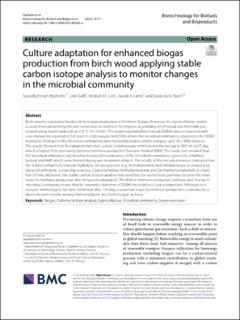Culture adaptation for enhanced biogas production from birch wood applying stable carbon isotope analysis to monitor changes in the microbial community
Peer reviewed, Journal article
Published version
Permanent lenke
https://hdl.handle.net/11250/3110397Utgivelsesdato
2023Metadata
Vis full innførselSamlinger
Originalversjon
Biotechnology for Biofuels and Bioproducts. 2023, 16 1-18. 10.1186/s13068-023-02328-wSammendrag
Birch wood is a potential feedstock for biogas production in Northern Europe; however, the lignocellulosic matrix is recalcitrant preventing efficient conversion to methane. To improve digestibility, birch wood was thermally pre-treated using steam explosion at 220 °C for 10 min. The steam-exploded birch wood (SEBW) was co-digested with cow manure for a period of 120 days in continuously fed CSTRs where the microbial community adapted to the SEBW feedstock. Changes in the microbial community were tracked by stable carbon isotopes- and 16S r RNA analyses. The results showed that the adapted microbial culture could increase methane production up to 365 mL/g VS day, which is higher than previously reported methane production from pre-treated SEBW. This study also revealed that the microbial adaptation significantly increased the tolerance of the microbial community against the inhibitors furfural and HMF which were formed during pre-treatment of birch. The results of the microbial analysis indicated that the relative amount of cellulosic hydrolytic microorganisms (e.g. Actinobacteriota and Fibrobacterota) increased and replaced syntrophic acetate bacteria (e.g. Cloacimonadota, Dethiobacteraceae, and Syntrophomonadaceae) as a function of time. Moreover, the stable carbon isotope analysis indicated that the acetoclastic pathway became the main route for methane production after long-term adaptation. The shift in methane production pathway and change in microbial community shows that for anaerobic digestion of SEBW, the hydrolysis step is important. Although acetoclastic methanogens became dominant after 120 days, a potential route for methane production could also be a direct electron transfer among Sedimentibacter and methanogen archaea.
